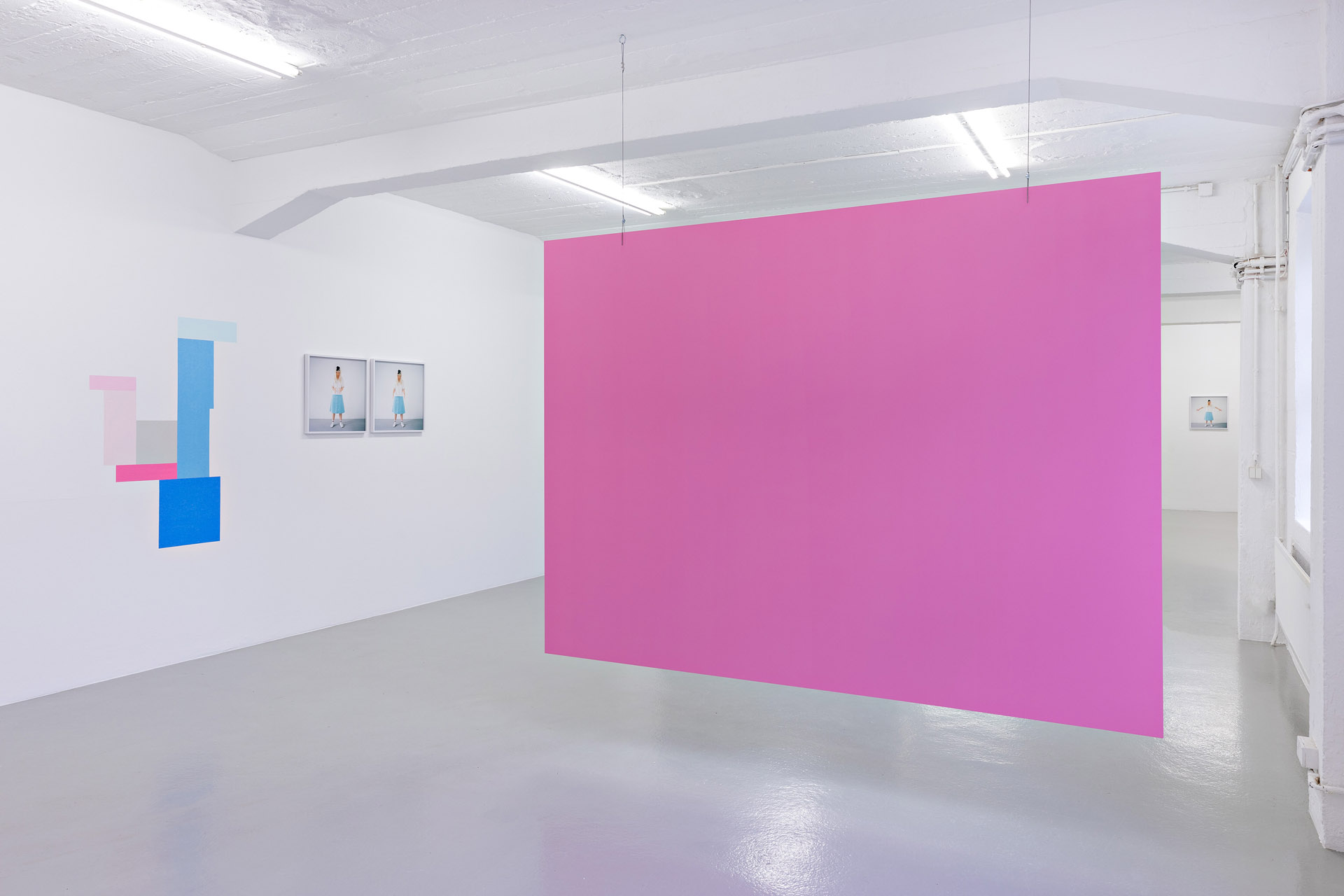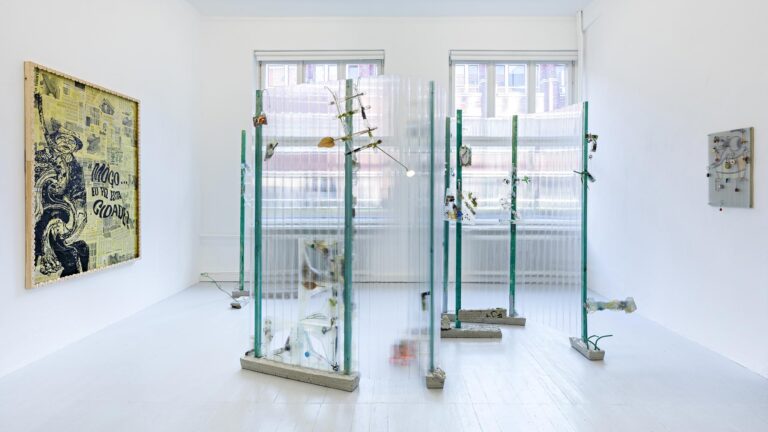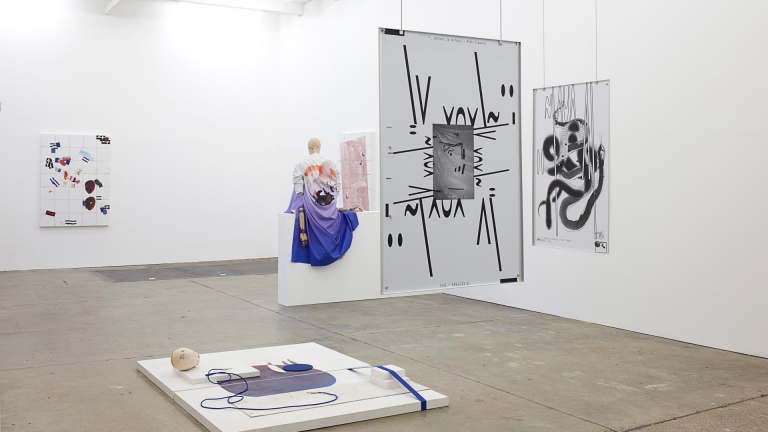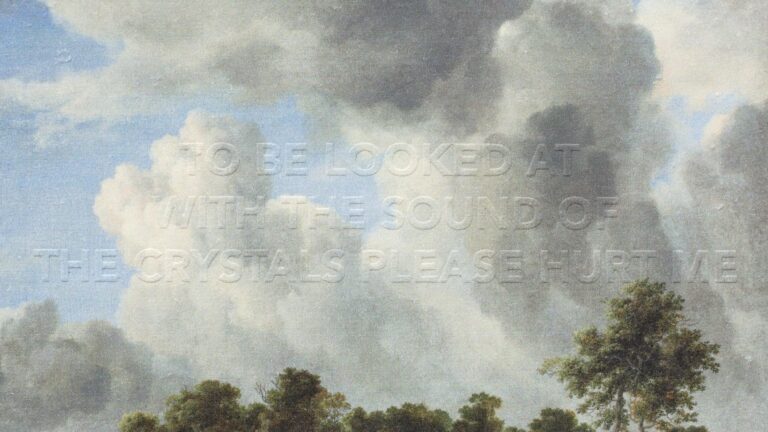Artist: Irina Gheorghe
Exhibition title: Methods for the Study of What Is Not There
Curated by: Nadja Quante
Venue: Künstlerhaus Bremen, Bremen, Germany
Date: September 25 – November 21, 2021
Photography: all images copyright and courtesy of the artist and ©Künstlerhaus Bremen
The exhibition Methods for the Study of What Is Not There includes a series of drawings, a space-specific installation, a performance on the opening day, and a sound work. In these works, Gheorghe addresses absences. She creates a semiotic system in which she refers to invisible presences with the help of colors, forms, gestures, spoken word, and photography. Methods for the Study of What Is Not There is part of a long-term research project on non-perceptible realities in which the artist explores art, philosophy, natural sciences, and occultism. How can we refer to things and worlds that are unobservable or intangible? How can we experience the metaphysical? What are the limits of the empirically experienceable? How do we talk about spaces or things that we cannot perceive? And what role does the body take in these acts of speculation? Gheorghe chooses different methods and forms to investigate these questions.
The drawings from the series Things of Which We Cannot Say (2017–ongoing) form a starting point for the artist’s research. She draws them in notebooks where they resemble diagrams for a secret science, cartographies, or floorplans for unknown spaces. The formally rigorous pencil drawings and tape collages are composed of rectangular areas of color. Here, Gheorghe has developed a color scheme in which every color represents a different category of absence: one for things that are not here, which are; one for things that are not here, which are not; one for things of which we cannot tell whether they are or they are not; one for things that are not here but could, with some form of support; and one for things that are not here and could not be here, irrespective of any form of support, and so on. Gheorghe draws these maps as preliminary studies for her performances. They are scores or notations for the construction of imaginary spaces.
In the performance Preliminary Remarks on the Study of What Is Not There (2017–ongoing), staged on the opening day of the exhibition, Gheorghe uses body language and voice to connect the existing space with another dimension of existence. Through language and gestures, she unfolds an imaginary map of intangible presences in the space. She takes on a “psychic agency” and divides the space into different categories of the invisible. While the drawings are the starting point, she uses the performance as a tool for navigating the imperceptible space. Gheorghe’s movements and language are partly scripted and partly situational or improvised. By interacting with the audience through eye contact or direct address, she breaks the fourth wall. Her choreography is more an intervention than the staging of a performance, and she challenges the audience to follow her construction of an invisible architecture. Language functions as a scaffolding for an imaginary space. It involves the surrounding architecture, the spatial situation, and the relationship to the viewer. It is the opposite of an aesthetic experience where there is a subject and object, and rather, is an experience of thinking together. Gheorghe’s body language is based on a system of gestures developed by the artist. By executing gestures that measure, mark, and divide the space, they refer to the realm of the invisible. They are performative gestures in the original sense of the word because their execution generates a new reality or dimension. The gesture with which she divides the space into different areas and assigns them different categories of being is reminiscent of the edges of a photograph – of the fact that it always represents only a temporal and local section of reality.
In Gheorghe’s sound work Routes to What Is Not There (2020), which is accessible in the exhibition and online, the performance expands into a score for the listener. The role of the voice becomes particularly prominent here. How is meaning generated through language, text, or the tone of the voice? Particularly when listening more closely, the absurdity of the text becomes more evident – grammar and voice, by contrast, create and embody a credibility, and language is exposed as an arbitrary linguistic system.
The installation All the Things Which Are Not There (2018–ongoing) comprises photographs, colored panels, and tape drawings. Some elements of the drawings can also be found in the installation in the gallery space. Panels painted in colors of the same scheme as that of the drawings divide the space and limit the visitors’ movements. Colored tape arrangements form and mark different spaces on the wall.
Photographs from the series Methods for the Study of What Is Not There (2019–ongoing) show the artist, dressed in a light blue skirt and a white shirt, execut-ing gestures from the vocabulary that she uses in her performances. They were taken in the context of previous iterations of the performance Preliminary Remarks on the Study of What Is Not There (Chang-ing Room, Berlin and Swimming Pool, Sofia). The two photographic series present an ongoing archive of the performed vocabulary of gestures that neverthe-less remain indecipherable and fragmentary. Further-more, the photographs are evidence of the former events and add a temporal layer. For semiotician Ro-land Barthes, an essential quality of photography lies in its indexical character – the fact that a photograph testifies that something was at a certain place at a certain time. Thus, for Barthes, every photograph also represents an embodiment. But the photographs in Gheorghe’s installation seem to elude their indexical character. In the grouping and arrangement of the photographs with and on the tape drawings, elements of earlier scores overlap and create an idiosyncratic temporality that distorts the present.
The different elements in the installation create an atmosphere of ambiguity and alienation. Invisible spaces are translated into vocabularies that enable their perception: by drawing, gesture, spoken word, photography, and architecture or spatial constellations. Gheorghe also applies methods or means that attempt to provide evidence or generate knowledge while at the same time exploring the limits of the methods that go beyond our experience. The artist moves in the hypothetical realm of the speculative and marks the borders of that which can possibly be depicted or represented. As a result, her work is not easy to grasp or write about. However, I understand this to be the essential quality of her practice. It deliberately eludes comprehension and leaves the spectator estranged, and instead of filling the different elements with meaning, Gheorghe exposes how meaning is generated through linguistic structures, performance, imagery, and photography.
Gheorghe’s exhibition refers to the alienation triggered by the experience of absence. It reinforces the inadequacy and imprecision of the forms of representation: the drawing is only an attempt to capture in an image something that cannot be said, the word is only an attempt to describe what cannot be shown, the photograph is an attempt to capture what might have been.
Irina Gheorghe, Preliminary Remarks on the Study of What Is Not There, 2017– ongoing, Performance in the exhibition Methods for the Study of What Is Not There, Künstlerhaus Bremen 2021, Photo: Fred Dott
Irina Gheorghe, Methods for the Study of What Is Not There, exhibition view, Künstlerhaus Bremen 2021, Photo: Fred Dott
Irina Gheorghe, Methods for the Study of What Is Not There, exhibition view, Künstlerhaus Bremen 2021, Photo: Fred Dott
Irina Gheorghe, Things of Which We Cannot Say, 2021, Collages, tape on paper in notebook, 17,6 cm × 25 cm
Irina Gheorghe, Things of Which We Cannot Say, 2021, Collages, tape on paper in notebook, 17,6 cm × 25 cm
Irina Gheorghe, Methods for the Study of What Is Not There, 2019–ongoing, Chrome pigment print on Hahnemühle paper, 50 x 50 cm
Irina Gheorghe, Methods for the Study of What Is Not There, exhibition view, Künstlerhaus Bremen 2021, Photo: Fred Dott
Irina Gheorghe, Methods for the Study of What Is Not There, exhibition view, Künstlerhaus Bremen 2021, Photo: Fred Dott
Irina Gheorghe, Preliminary Remarks on the Study of What Is Not There, 2017– ongoing, Performance in the exhibition Methods for the Study of What Is Not There, Künstlerhaus Bremen 2021, Photo: Fred Dott
Irina Gheorghe, Methods for the Study of What Is Not There, exhibition view, Künstlerhaus Bremen 2021, Photo: Fred Dott
Irina Gheorghe, Methods for the Study of What Is Not There, exhibition view, Künstlerhaus Bremen 2021, Photo: Fred Dott
Irina Gheorghe, Methods for the Study of What Is Not There, exhibition view, Künstlerhaus Bremen 2021, Photo: Fred Dott
Irina Gheorghe, Methods for the Study of What Is Not There, exhibition view, Künstlerhaus Bremen 2021, Photo: Fred Dott
Irina Gheorghe, Preliminary Remarks on the Study of What Is Not There, 2017– ongoing, Performance in the exhibition Methods for the Study of What Is Not There, Künstlerhaus Bremen 2021, Photo: Fred Dott
Irina Gheorghe, Methods for the Study of What Is Not There, 2019–ongoing, Chrome pigment print on Hahnemühle paper, 50 x 50 cm
Irina Gheorghe: All the Things Which Are Not There (2021), tape on wall, installation view, Künstlerhaus Bremen 2021, Photo: Fred Dott
Irina Gheorghe, Methods for the Study of What Is Not There, exhibition view, Künstlerhaus Bremen 2021, Photo: Fred Dott
Irina Gheorghe, Methods for the Study of What Is Not There, exhibition view, Künstlerhaus Bremen 2021, Photo: Fred Dott
Irina Gheorghe, Methods for the Study of What Is Not There, exhibition view, Künstlerhaus Bremen 2021, Photo: Fred Dott
Irina Gheorghe, Methods for the Study of What Is Not There, exhibition view, Künstlerhaus Bremen 2021, Photo: Fred Dott
Irina Gheorghe, Methods for the Study of What Is Not There, exhibition view, Künstlerhaus Bremen 2021, Photo: Fred Dott
Irina Gheorghe, Methods for the Study of What Is Not There, exhibition view, Künstlerhaus Bremen 2021, Photo: Fred Dott
Irina Gheorghe: All the Things Which Are Not There (2021), tape on wall, installation view, Künstlerhaus Bremen 2021, Photo: Fred Dott
Irina Gheorghe, Methods for the Study of What Is Not There, exhibition view, Künstlerhaus Bremen 2021, Photo: Fred Dott
Irina Gheorghe, Methods for the Study of What Is Not There, exhibition view, Künstlerhaus Bremen 2021, Photo: Fred Dott































